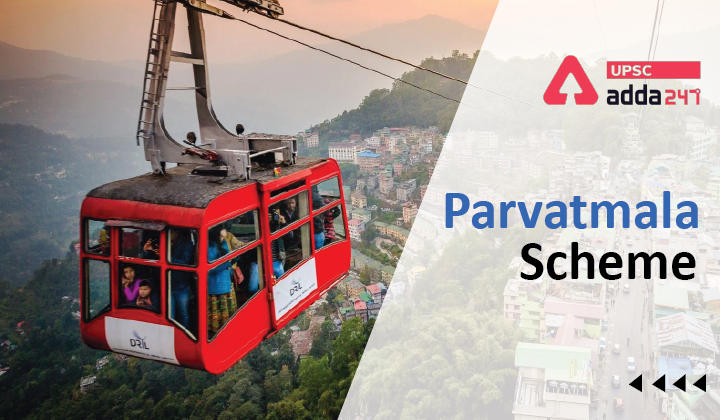Table of Contents
Parvatmala Scheme: Relevance
- GS 3: Infrastructure: Energy, Ports, Roads, Airports, Railways etc.
Get Free Study Material for UPSC and State PCS Examinations
Parvatmala Project: Context
- Union budget 2022-23 has announced a National Ropeways Development Programme— “Parvatmala”—to improve connectivity and convenience in hilly areas.
Parvatmala Programme: Key points
- Developing an efficient transport network is a big challenge in hilly areas.
- The rail and air transport networks are limited in these areas, while the development of road network has technical challenges.
- In this backdrop, Ropeways have emerged as a convenient and safe alternate transport
Ropeway development in India
- The Ministry of Road Transport and Highways (MORTH) is responsible for development of Highways and regulating the road transport sector across the country.
- Government of India (Allocation of Business) Rules 1961 was amended, which enabled the Ministry to also look after the development of Ropeways and Alternate Mobility Solutions.
- The move will give a boost to the sector by setting up a regulatory regime.
- The Ministry will also have responsibility for development of ropeway and alternative mobility solutions technology, as well as construction, research, and policy in this area.
- Formulation of institutional, financial, and regulatory framework for the technology will also fall under the ambit of this allocation.
Parvatmala scheme
- Parvatmala will be taken up on PPP mode, which will be a preferred ecologically sustainable alternative in place of conventional roads in difficult hilly areas.
- The idea is to improve connectivity and convenience for commuters, besides promoting tourism.
- This may also cover congested urban areas, where conventional mass transit system is not feasible.
- The finance minister announced that contracts for 8 ropeway projects for a length of 60 km would be awarded in 2022-23.
- The scheme is being presently started in regions like Uttarakhand, Himachal Pradesh, Manipur, Jammu & Kashmir, and the other Northeastern states.
Factors driving ropeway infrastructure
- Economical mode of transportation: Given that ropeway projects are built in a straight line over a hilly terrain, it also results in lower land acquisition costs. Hence, despite having a higher cost of construction per km than roadways, ropeway projects’ construction cost may happen to be economical than roadways.
- Faster mode of transportation: Owing to the aerial mode of transportation, ropeways have an advantage over roadway projects where ropeways can be built in a straight line, over a hilly terrain.
- Environmentally friendly: Low dust emissions. Material containers can be designed to rule out any soiling of the environment.
- Last mile connectivity: Ropeway projects adopting 3S (a kind of cable car system) or equivalent technologies can transport 6000-8000 passengers per hour.
Benefits of ropeways
- Ideal for difficult / challenging / sensitive terrain
- Long rope spans: The system crosses obstacles like rivers, buildings, ravines, or roads without a problem.
- Ropes guided over towers: Low space requirements on the ground, and no barrier for humans or animals.
- This mode of transportation will enable mobility to people living in difficult areas and help them become part of the mainstream.
- Villagers / farmers living in such areas will be able to sell their produces in other areas, which in turn will help them grow their income.
- Economy: Ropeway having multiple cars propelled by a single power-plant and drive mechanism.
- This reduces both construction and maintenance costs. The use of a single operator for an entire ropeway is a further saving, in labour cost.
- On level ground, the cost of ropeways is competitive with narrow-gauge railroads; in the mountains the ropeway is far superior.
- Flexible: Transport of different materials – A ropeway allows for the simultaneous transport of different types of material.
- Ability to handle large slopes: Ropeways and cableways (cable cranes) can handle large slopes and large differences in elevation.
- Where a road or railroad needs switchbacks or tunnels, a ropeway travels straight up and down the fall line.
- The old cliff railways in England and ski resort ropeways in the mountains take advantage of this feature.
Also Read:





 TSPSC Group 1 Question Paper 2024, Downl...
TSPSC Group 1 Question Paper 2024, Downl...
 TSPSC Group 1 Answer key 2024 Out, Downl...
TSPSC Group 1 Answer key 2024 Out, Downl...
 UPSC Prelims 2024 Question Paper, Downlo...
UPSC Prelims 2024 Question Paper, Downlo...
